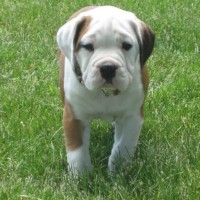Appearance of the English Bull Springer
|
| The English Bull Springer will vary in appearance due to the lack of a breed standard. The breed was developed from the English Bulldog and the English Springer Spaniel. Due to the absence of a breed standard, this hybrid breed can inherit characteristics from both parent breeds. The face resembles the English Springer Spaniel, with a longer muzzle. The ears may resemble the Bulldog with the ear folded back. The expression is that of a curious but reactive dog. Its strong, muscular build can be attributed to the English Springer Spaniel. His coat can vary in color with white, brown, tan and black. Its tail is generally fine with a few feathers on top. |
Temperament of the English Bull Springer
|
| The English Bull Springer is not a nuisance barker, and only barks if it senses danger. It's an affectionate, friendly family dog that adapts well to any situation. This breed is ideal for families and young children. While they welcome people, they can be hesitant around strangers. Early training and socialization are necessary to prevent your English Bull Springer from becoming too upset. Otherwise, this loving dog is reliable and eager to please. This breed is generally friendly with other dogs, but requires a little time and patience with small animals. Extra care should be taken when introducing a small animal for the first time. Once it is fully trained, it will welcome its new friend. Positive reinforcement and rewards in the form of treats will be an excellent way to win his heart. His moderate energy level means he'll need daily exercise to meet his needs. |
Needs and activities of the English Bull Springer
|
| Your English Bull Springer has moderate energy levels, which can be achieved by running, walking to the park or even fetching a ball. Two brisk walks a day are recommended to ensure he meets his minimum requirements, and these times together are also beneficial for the all-important human-dog bond. Apartment living is acceptable as long as your hybrid enjoys daily outdoor access, although your English Bull Springer is best suited to an urban home with a fenced-in yard. A warm climate is ideal, and time spent outdoors at any time of year should include plenty of fresh water to drink. Avoid situations where your dog is left home alone for many hours at a time. He may resort to unwanted destruction of property. |
Maintenance of the English Bull Springer
|
| The English Bull Springer is not considered a hypoallergenic hybrid breed, although it does shed moderately. Daily brushing for 10 to 15 minutes will keep them clean and elegant. Bathing should be limited to every 6 to 8 weeks to avoid overproduction of oils in the skin. When bathing your English Bull Springer, be sure to use a veterinarian-approved shampoo to avoid irritating the skin with a harsh product. Ears should be wiped and cleaned weekly, looking for excessive moisture inside. Teeth should be brushed daily to prevent tartar build-up. Nails should always be well groomed and trimmed or filed every 2-3 weeks. This breed has low levels of drool and no significant odor. |









 English (United Kingdom)
English (United Kingdom)